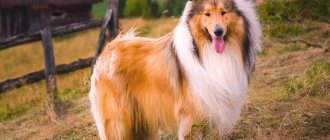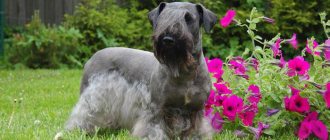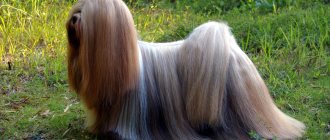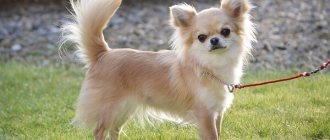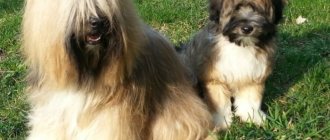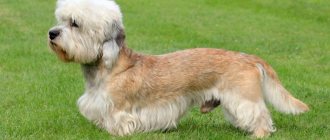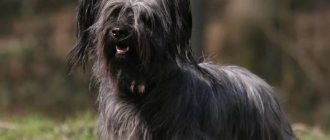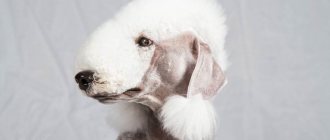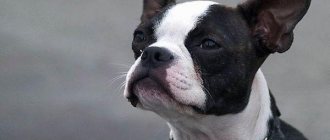Characteristics and description of the breed
Height: up to 30 cm at the withers.
Weight: males 5.8-7.3 kg, females 5-6.8 kg
Color: red, sand, blue and gray with tan. Brown and black colors are not acceptable.
Coat: hard, thick, with dense undercoat.
Eyes: dark.
Nose: dark, perhaps brown or liver color.
Body: moderately high, straight legs, narrow elongated body, deep chest. You can clasp the palms of both hands behind the terrier's shoulders. Narrow shoulders, an elongated body and strong jaws allow them to hunt foxes, badgers, and otters in burrows.
Main characteristics
| Breed parameters | |
| Country of origin: | England |
| Weight of the breed: | males: 6-7 kg, females: 5-6 kg |
| Height at withers: | males: 33-40 cm, females: 28-36 cm |
| Temperament: | active |
| Wool: | short |
| Role in human life: | companion, hunting, guard |
It is difficult to find another breed that would be distinguished by such irrepressible character and energy. They are constantly on the move and almost never get tired. They are ready to give of themselves 24 hours a day.
History of the Border Terrier breed
Borders are bred by crossing English and Scottish terriers. The first mention of the breed dates back to 1880. Their purpose is to hunt foxes, badgers, raccoons and otters . Borders were kept by hunters, less often by shepherds and farmers.
The climate on the border of Scotland and England, where the Border Terrier was bred, left its mark on the representatives of the breed - this is a hardy, strong dog, accustomed to the harsh climate. Its hard coat protects it from bad weather.
The first Border Terrier was presented at an exhibition in 1913, and in 1920 a breed club was formed in England.
When breeding, breeders paid more attention specifically to the working qualities of the Border, without paying much attention to the exterior.
Origin story
The Border Terrier was bred in the Border Country on the border between Scotland and England for burrow hunting. Small, wire-haired dogs have been known in these areas since the end of the 18th century. The systematic formation of the breed began half a century later, at a time when fox hunting with packs of dogs became very popular in the mountains of the Border Country. Initially, terriers were named after the areas and families in which they were kept, and only at the end of the 19th century the breed received its modern name. The English Kennel Club officially recognized the breed in 1920 and duly appreciated the typical qualities of Border Terriers.
Border Terriers are especially popular in the UK. Up to 4,000 puppies are registered in the country every year. Significant numbers are concentrated in Sweden, Finland and Germany. For Russia, borders still remain exotic. The first representatives of the breed arrived in Moscow in 1998. Today they live mainly in large cities.
Video about the Border Terrier dog breed from AnimalPlanet:
Behavior and temperament
Borders are dogs with extremely high intelligence and excellent working qualities. But the potential owner should note that these are working dogs . Active, strong, physically resilient - they need constant and regular physical activity in large quantities , otherwise the borderer will find an outlet for his energy by destroying furniture.
Borders are loyal to their owners, have highly developed guarding skills and get along well with other dogs. Their disadvantage can be considered a rather stubborn character, which will be difficult for a soft person to cope with.
Borders are active and fearless, but calm and friendly towards people.
The great advantage of Border Terriers is their balance - these dogs are not prone to empty barking or hysteria.
Overall, this is an excellent companion dog if a person is willing to devote enough time to raising it.
Dog and man
Not only a hunter will be a good owner for a border terrier . The Border will be an excellent family dog, given sufficient attention and the necessary exercise.
A person who prefers to spend his free time lying on the sofa is contraindicated in owning a Border Terrier. In this case, both the dog and its owner will suffer.
Border Terriers are not aggressive towards people and children and can be an excellent playmate for a child.
They get along well with other dogs; relationships with cats can develop relatively peacefully if the animals are kept together from childhood. But one day the hunting instinct may awaken in the border. Since this breed is intended for hunting burrowing animals, it is not recommended to keep rabbits, ferrets, and chinchillas with the dog.
Fun fact: Border Terriers are suitable for social work and participate in Animal Assisted Therapy programs in nursing homes and children's hospitals. The openness and kindness of borders helps them establish contact with closed people.
History of the breed
The Border Terrier breed was bred specifically to fight foxes, which plagued farms in the 18th century. In addition to protecting farmlands, the border dog was excellent at hunting pests, thus bringing valuable fur to local residents.
One of the earliest evidence of the existence of these animals is a painting by A. Wentworth from 1754, which depicts two border terriers. At that time, throughout almost the entire territory of England, these dogs were highly valued and were successfully used both for protection and for hunting. At the same time, practically nothing was known about them outside the country.
Only by the end of the 20s was the breed recognized by the English Kennel Club and they went beyond the territory of the country. But unfortunately, even after recognition, the breed remained not particularly in demand and popular. Even after a quarter of a century, these small hunters remain little known.
They are known most of all in their historical homeland and the United States, much less in Europe and the CIS. However, low popularity has a positive effect on the purity of the breed and its basic characteristics. Terriers have not changed much since their inception and remain truly magnificent pets for cheerful and energetic people.
Maintenance and care
A place to live
Suitable for both residents of country houses and apartment living. But remember that borders who permanently live in an apartment will need long walks - about 2-3 hours a day.
When keeping a border dog in a private house, the dog will be happy to walk on the property. But you should prepare for the fact that the terrier will dig holes, so the landscape design may suffer.
Walks
The average duration of walks is 45 minutes . The terrier needs to be walked 2-3 times a day.
In this case, 30 minutes should be devoted to training and games.
Feeding
Border Terriers can become real gluttons - they have a good appetite. Therefore, to feed them often and in small portions so as not to provoke the development of obesity.
Suitable for feeding: beef heart, tripe, liver, udder, trimmings. The meat must be boiled or pre-frozen for 1-2 days. It is not recommended to give raw fresh meat to your dog!
The diet should also include vegetables, fermented milk products (cottage cheese, fermented baked milk - except kefir, which is a laxative), quail eggs, and porridge. In winter, when kept outdoors, add a piece of lard to the food - 10-15 grams every few days.
The dog should not be given fatty, fried, sweet, or smoked foods.
Grooming
Periodic trimming - plucking the fur. Borders should be bathed no more than once a month.
Nails need to be trimmed once every 2-3 weeks, since a dog kept as a pet does not have time to grind them down. Treat ears and eyes once a week.
You should carefully monitor the condition of the paw pads - during a walk, the dog can cut itself or stumble upon something sharp. Paws should be checked after every walk.
Care and maintenance
These dogs are not very picky about their living conditions; they can live both in an apartment and in a private house. They are not afraid of high and low temperatures. Of course, if a dog lives in an apartment, then it needs daily walks of about 1.5-2 hours twice a day, and this is the minimum.
Walking around the yard on a leash will not be enough for her; she needs to “walk” her hunting abilities and natural skills for this craft in a public garden, park, or forest. But, the dog must be trained in commands and follow commands flawlessly.
Dogs do not need special care or special haircuts. It is enough to bathe them once every 10-15 days with an appropriate shampoo, and comb their coat once a week with a special brush. You need to clean your ears approximately once a month to avoid diseases.
It is necessary to wipe your eyes with a special solution or chamomile decoction. Timely visits to the veterinarian are necessary, who will monitor the pet’s health, give recommendations and give the necessary vaccinations.
Education and training
Border puppies are very intelligent and easy to learn . They are strongly attached to their owner and try to please him in any way, so there are no problems with training.
You need to engage in upbringing from the first days of arrival in the house. Such dogs are not suitable for constant training; they need tasks aimed at developing intelligence.
It is advisable to develop working qualities in Border Terriers and take them hunting . Well, or periodically go out into the forest for walks.
Border terriers also realize themselves in dog sports. Agility, dog Frisbee, swimming, running, coursing (running after a mechanical hare) are suitable for them.
Health and life expectancy
The Border Terrier is endowed with good health. But some diseases do not bypass them. This:
- Obesity due to improper feeding;
- Dysplasia of the hip and elbow joints;
- Heart problems;
- Retinal atrophy (progressive);
- Cataract;
- Slow response to anesthesia.
On average, the Border Terrier lives 13-16 years .
Breed photo
A selection of photos of border terriers.

